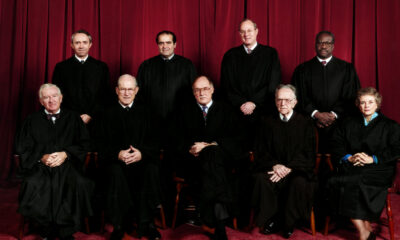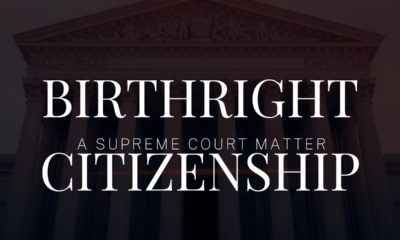Constitution
Executive powers – a split decision
The Supreme Court issued a split decision on executive powers in America, showing deference in one case and setting limits in another.
The Supreme Court today closed out its momentous 2021 Term with a split decision on executive powers of the President. Sadly, the Court almost punted on the immigration case, Biden v. Texas (21-954). But in West Virginia v. Environmental Protection Agency (20-1520), the Court thumped the EPA, saying it clearly exceeded its authority. Chief Justice Roberts wrote both opinions, with Justice Brett Kavanaugh joining him on both. This and the Torres v. Texas DPS case clearly show that Roberts and Kavanaugh are the moderate team, moving forward.
Supreme Court update
With these two cases, the Supreme Court closes out the 2021 Term and have no further opinions to issue. That might partly explain why Justice Stephen G. Breyer decided abruptly to retire today instead of waiting until the fall. Accordingly, Ketanji Brown Jackson will take the oath of office today at noon EDT. CNAV has discussed soon-to-be-Justice Jackson’s qualifications before.
In any case, CNAV plans no further Supreme Court updates until the fall. Only another Court retirement – or death – falls within reasonable expectation for a change in that plan.
Executive powers – background
CNAV set forth a background on these two cases yesterday, after the Court deferred until today their issuance of opinions. Here, for the benefit of readers, are the two cases – the Biden case first, then the EPA case.
Briefly, CNAV feels that past Presidents have abused their executive powers for a very long time – because Congress let them. A general consensus seems to have arisen that “elections have consequences.” Therefore, a President speaks with vox populi and therefore what he says, goes, subject to proper attention to duty. This holds especially in matters of war and foreign policy or anything touching them.
Immigration is one of those matters, and is the matter at hand in Biden v. Texas. The syllabus, and Chief Justice Roberts’ opinion, provides additional background. Specifically, SecHomeSec Alejandro Mayorkas issued two memos terminating the Remain in Mexico policy – on June 1, then on October 29. Texas and Missouri both sued in a district court, alleging that Secretary Mayorkas had broken two laws:
- The Immigration and Nationality Act, specifically 8 U. S. C. §1225(b)(2)(c), and
- The Administrative Procedures Act.
Options in the immigration case
That first law gives the government two options if they’re swamped with people trying to crash the border, and can’t detain them all: either
- Release them on parole (meaning literally they give the government their word of honor to show up for hearings), or
- Send them back to Mexico.
The United States is an illegal immigration magnet. Chief Justice Roberts almost said as much. He observes that every President starting with Clinton has released undocumented migrants on parole. Even Donald Trump did – but he also removed some of those migrants back to Mexico.
The Biden Administration was having none of that. A different administration means a different governing philosophy. In this case, perhaps this administration believes that these swarms of people crossing the Rio Grande without documentation, will eventually make a better class of citizens than are those born in-country to lawful-resident parents or who came lawfully. That’s a question no court can decide. The American people will decide that at Midterms.
In the matter at hand, Secretary Mayorkas ended the Remain in Mexico policy on June 1. Texas and Missouri, two States who have to care for some of these immigrants, sued. So the District Court enjoined the federal government to continue Remain in Mexico until the government could build enough jails to detain everyone whom the law tells it to detain. The District Court expressed fear of the release of millions of people into the country. They also found the rescission “arbitrary and capricious.”
A new reason
In October 29, Secretary Mayorkas wrote another memo ending the Remain in Mexico program. This time he offered what he considered a new and better rationale. In fact that second memo clearly shows that the Biden administration places a high value on a welcoming posture. The Secretary admits that Remain in Mexico cut down on the number of people trying to cross illegally. But he insists that the program’s
benefits do not justify the costs, particularly given the way in which [Remain in Mexico] detracts from other regional and domestic goals, foreign-policy objectives, and domestic policy initiatives that better align with this Administration’s values.
He also cited the diplomatic complications of the Remain in Mexico policy. After all, if certain persons must “remain in Mexico,” Mexico has to take care of them. Trump persuaded the Mexicans to take care of them. Biden – or his handlers – have other ideas. Again, the American people must decide this question at Midterms, then two years later.
By then the case was before the Fifth Circuit Court of Appeals. They affirmed the District Court’s judgment in full. By their read of Section 1225, Remain in Mexico was the only way to avoid releasing large numbers of people on an unlawful general parole. The Appeals Court also rejected the October 29 memo as merely another attempt to explain an old decision.
Roberts: government is within its executive powers
The Supreme Court – meaning Chief Justice Roberts – seized upon the word may as it appears in Section 1225. In other words, if the government wants to release large numbers of people into this country without evaluating them (because evaluating so many would take too long), then the government is perfectly within its executive powers to do so. When he does this, Roberts continues the traditional deference to the executive in foreign affairs. But he forgets that immigration is more a domestic than a foreign affair. Immigrants eventually become voting citizens, under our system of universal adulthood suffrage. And given the availability – per a mandate that the Congress under Lyndon Baines Johnson handed down – of generous public-charge benefits, most of the new immigrants the government will continue to release into the country will become public charges.
The only possible escape from this is that the Court did not make this the final word. Instead it remanded the case for reconsideration in light of the Administrative Procedures Act. A question still remains whether the October 29 memo satisfied the requirement that the department follow its pre-arranged procedures.
This case ended up turning on a grammatical question. Congress was sloppy in its writing of that section of the Immigration and Nationality Act. Had it consistently said shall where it said may instead, the case might have turned out differently. Even so, Roberts and Kavanaugh both want to defer to the President in foreign policy.
Excession of executive powers – the Clean Power Plan
In sharp contrast to the immigration debacle, the Court significantly reined in the Environmental Protection Agency. It’s about time – for the matter at hand is now thirteen years old. Thirteen, because the controversy began in 2009 when then-President Barack Obama introduced his cap-and-trade scheme in the House and Senate. Technically, he asked one pair each of Representatives and Senators to do it for him.
As CNAV said yesterday, Congress did not pass the Waxman/Markey/Kerry/Boxer cap-and-trade scheme. The reasons for this do not concern the Court, mainly because never, from that year to this, did anyone summon any of Drs. Michael Mann, Phil Jones, Kevin Trenberth, Rajendra Pachauri, Christiana Figueres, or any other prominent “Climategate” personality, to sit at the green table and testify under oath to what they represented as their scientific conclusions that:
- Climate change presents a clear and present danger none can longer seriously doubt,
- Human beings must bear a significant and remediable portion of the blame for it,
- Carbon dioxide emissions are the means for this blameworthy activity that governments must curtail,
- The Earth has warmed, in “atmosphere, land and water,” and
- We can see the bad effects of this warming all around us, especially:
- “Heat-related death” and disease,
- “Coastal inundation and erosion,”
- “More frequent and intense hurricanes, floods, and other extreme weather events,”
- “Drought,”
- “Destruction of ecosystems,” and
- “potentially significant disruptions of food production.”
(Kagan J. dissenting; paraphrase)
The tipping point in 2015
After the cap-and-trade scheme failed, the EPA invoked a little-known and very seldom used section of the Clean Air Act. Section 111 lets the EPA, alone, determine whether a given substance pollutes the air and “endanger(s) public health and welfare.” Section 111 covers any polluting substance not already listed as hazardous or that “ambient air quality” standards cover.
The EPA designated carbon dioxide as a pollutant under Section 111. But for many years the EPA did little beyond trying to regulate carbon dioxide at power-plant sources. In 2015 the EPA changed course. They came up with new rules, one for new power plants and the other for existing ones, to reduce carbon dioxide emissions. The second set of rules, for the existing power plants, became the Clean Power Plan. At first the agency sought to improve the efficiency of existing power plants. But that was almost a non-starter, because those plants were already at best efficiency, or nearly so.
So the EPA took upon itself to mandate what it called “generation shifting.” (That refers to generation of power, not new generations of development.) Under these rules, a power plant operator could do one of three things:
- Curtail production of electricity,
- Build or invest in a new natural gas plant (at first), wind farm, or solar farm, or
- Buy an emissions credit form the operator of one of those kinds of plants.
Thus the EPA sought to move electricity to natural gas and “renewables.”
The Trump Administration
The EPA’s requirements for existing power plants were in fact stricter than those for new plants. For whatever reason, not one word of the opinion addresses nuclear power plants. (Indeed the word does not appear in the slip opinion.)
The very day the EPA announced its new rules, “dozens of parties” applied for a stay of the rule. The D.C. Court of Appeals declined, but the Supreme Court granted the stay. After that, the D.C. Circuit granted an en banc hearing (before all the judges). But before the hearing could take place, President Donald Trump took office. His EPA administrator asked the D.C. court to wait until he had a chance to review the Clean Power Plan. The court agreed, and later dismissed all the petitions as moot.
In 2019, Trump’s EPA administrator rescinded the Clean Power Plan. He concluded that his predecessor(s) had exceeded the authority Congress granted the EPA. Specifically, forcing the industry to shift from one set of fuels to another raised a “major question.” This was the sort of question only Congress, not any executive agency, could decide. In fact Trump’s official quoted Antonin Scalia from Utility Air Regulatory Group v. EPA (2014):
We expect Congress to speak clearly if it wishes to assign to an agency decisions of vast economic and political significance.
Instead, the official promulgated the Affordable Clean Energy rule. Which meant: back to regulating emissions one plant at a time, through better operating efficiencies.
The tree-huggers call for the original exercise of executive powers
At once several “blue States” and environmental groups sued to scrap the Affordable Clean Energy Rule. They wanted the Clean Power Plan to take full force and effect. The D. C. Appeals Court then held that the EPA was right the first time – meaning back in 2015. They found in Section 111 ample authority to mandate moving an entire industry away from coal. (And eventually away from all fossil fuels, though at the time they contemplated burning natural gas.)
That decision came down on January 19, 2021. On the very next day, a new administration, with a new philosophy, took the oath of office. But they weren’t so sure they wanted to go to the Clean Power Plan. One thing that had happened in the last year of the Trump administration, was a series of stay-at-home and other economic shutdown orders – this after the appearance of SARS-CoV-2, or “coronavirus.” That changed the baseline for carbon emissions. Perhaps for that reason, the new EPA wanted to write its own Clean Power Plan, not dust off Obama’s plan. So they asked the D. C. Appeals Court to stay its own decision.
Rather than wait to see what fresh mischief a Biden EPA might invent, the original petitioners asked the Supreme Court to step in. Which they did.
Reining in executive powers
Chief Justice Roberts delivered the opinion of the court, which carried 6-3 with Breyer, Kagan and Sotomayor dissenting. First, the Court disposed of one almost specious argument the government made. It said the stay of the repeal of the Clean Power Plan, and the EPA saying it would not enforce it, made the case moot. And therefore the petitioners had no standing before the Court. Wrong, said Roberts. First, the petitioners would have an injury in fact from having to enforce, or comply with, an incredibly burdensome regulation. Second, Roberts drily said the Court does not declare a case moot on a statement of good intentions. Particularly when, as in this case, the EPA stood by its authority to act, the very authority in question.
Turning to the merits, Roberts noted that the Utility Air case barely authorized the EPA to regulate “greenhouse gases.” Even so, the Court found that Congress did not authorize anything like the Clean Power Plan. Absent a clear statement of such authority, the EPA clearly took too much on itse.f
Roberts perhaps had a chance to challenge the very notion of Congressional delegation of legislative authority. He did not – but he did observe that the Supreme Court, going clear back to John Marshall, has set limits. The EPA exceeded those limits in 2015 when it wrote the Clean Power Plan.
Plenty of precedent
In ruling against the government, Roberts cited too many precedents to list here. These precedents all found that an executive branch agency had exceeded its authority. Thus Roberts sought to remind us all that the Supreme Court takes seriously the limits on executive powers. These limits apply especially when a given regulatory scheme fails to pass several times. Which was the definite case with cap-and-trade schemes like the Clean Power Plan. And also when such regulation falls far beyond a given agency’s expertise – such as how to balance an electric grid.
In fact Roberts noted positively that the Clean Power Plan was designed to destroy coal as an affordable generating mode. The agency made a decision that abandoning coal would be best for the country.
Sadly, the Court did not take up the question of whether Congress ever could authorize so drastic a scheme. The Court instead found that Congress did not authorize this one. Until it does, it can’t operate.
Justice Neil Gorsuch’ concurrence raises another damning question: whether the EPA was making ex post facto law. He cites opinions going back two centuries, saying the Constitution forbids writing or interpreting a statute with retroactive effect. He also holds that the sovereign immunity of States limits the federal government’s regulatory reach. Finally, he holds that Congress can never delegate to anyone the authority to write new law. That is why Congress, and not an executive agency, must decide “major questions” of public policy.
Kagan: but the globe is warming, the globe is warming!
Justice Kagan wrote the dissent. In it she tries to assert that Congress did authorize the EPA to identify, and address, major “environmental challenge(s).” That, she seems to say, applies whether Congress contemplated such challenges at the time – or not.
Like many dissents by her colleagues Breyer and Sotomayor this Term, Kagan concentrates on effects, not law. She asserts – on no warrant other than biased sources – that carbon dioxide is a catastrophic pollutant. Those sources include the United Nations Intergovernmental Panel on Climate Change, whom she would have us trust implicitly.
And herein lies the trouble with the jurisprudence of the Leftist Caucus of the Court. They forget that the Supreme Court is an appellate court, not a trial court. In this case Justice Kagan seems to be trying the case of Earth versus Humanity. The charge: murder of the Earth. And the specification: in that humanity uses energy in a manner that will destroy the Earth’s climate. Then she introduces reports by political and politicized agencies, with no opportunity for credential challenge or cross-examination.
Kagan cites the Clean Air Act itself, because Section 111 dates to its year (1970). Perhaps no one briefed her that in 1975 environmentalists warned of a deep freeze, not a deep bake. Therefore she cannot plausibly claim that Congress contemplated “greenhouse gas” emission reduction when it wrote the Act.
Plumping for more executive powers.
More to the point, Kagan, in this case, plumps for a vast extension of executive powers. She actually mentions “Members of Congress … not know(ing) enough” to make effective law in this area. So, she says, they leave it up to the experts. Whether they actually do – or not – was the subject of debate in this case. The Court voted NO. But one cannot dispute that she thinks Congress, and the people, should leave some kinds of lawmaking to the experts. Her ideal world, then, is a technocracy in which no one has any individual autonomy. In her world, one gains authority – and responsibility – through education, training, licensure, accreditation, and other such credentialing.
Kagan also observes previous delegations of legislative authority by Congress, and concludes that such delegation has no limits.
This is a dangerous philosophy. And if Congress and the States must amend the Constitution to curtail it, so be it. That any Justice of the Supreme Court could even think that Congress has a plenipotentiary power, should give us pause. That she furthermore holds that Congress may delegate any and all of its powers should call her qualifications into question.
In summary
Both immigration and the environment will become election issues. How important they will be, is an open question. American voters have seen a partial effect of the curfew, candlelight and curtailment regime the federal government really wants. At Midterms they will have a partial referendum on such policies, and on our open borders. In sum: if you want to leave your life to the experts, vote Democratic. If you believe yourself guilty of murder of the Earth, and believe masses of new immigrants will make a better class of citizen than you have made because they are new immigrants, again, vote Democratic. But if not, don’t.
CNAV rejects the Kaganite notion of a government by experts. So did the Framers. But in delegating any authority to executive agencies, successive Congresses have expanded executive powers. The clash between an ambitious President and those whom his policies would injure, was inevitable. The Supreme Court today granted us a reprieve. Now we must make the most of it.
Terry A. Hurlbut has been a student of politics, philosophy, and science for more than 35 years. He is a graduate of Yale College and has served as a physician-level laboratory administrator in a 250-bed community hospital. He also is a serious student of the Bible, is conversant in its two primary original languages, and has followed the creation-science movement closely since 1993.
-

 Civilization2 days ago
Civilization2 days agoDC Pipe Bomb Arrest Raises Questions About Christopher’s Wray’s FBI
-

 Civilization5 days ago
Civilization5 days agoYoo Hoo, VP Vance—Your Character is Showing!
-

 Executive5 days ago
Executive5 days agoThe Last Supper: New York’s Socialist Feast
-

 Guest Columns4 days ago
Guest Columns4 days agoCongressional Leaders See Far Higher Stock Returns Than Peers
-

 Civilization3 days ago
Civilization3 days agoThe Legal Logic Behind U.S. Operations Against Narco-Terrorist Networks
-

 Civilization5 days ago
Civilization5 days agoFacing Facts & Rolling Back Mythologies: The New National Security Strategy
-

 Civilization4 days ago
Civilization4 days agoHow Trump Changed America
-

 Executive3 days ago
Executive3 days agoNewsom’s ‘National Model’ for Homeless Wracked by Fraud















[…] the Supreme Court threw up a breastwork against further compromise of separation of powers. In West Virginia v. Environmental Protection Agency, the Court held that sweeping economic transformations need real, old-fashioned law. Executive […]
And people need to remember that Ketanji Brown Jackson, like Mrs Sotomayer and Mrs Kaegan, is not a Supreme Court Justice. Mr Biden is not actually President under the US Constitution due to Mrs Harris not being a natural born Citizen of the US, that is born in the US of a US citizen mother and US citizen father. Since the Electoral College is selecting the President and Vice President as a team she invalidates the Electoral College vote. Mr Obama and Mr McCain have the same issues.
[…] Alphabet Soup Agencies could certainly qualify. As it is, the Supreme Court recently set a boundary that, from now on, no agency may cross. (West Virginia v. EPA, 20-1530, and consolidated cases.) […]
[…] This is Friday the 8th of July in the year of our Lord 2022.1 I will be talking about the recent decision of the Supreme Court of the United States in the case of West Virginia v. Environmental Protection […]
[…] is the nearest equivalent to the abuses at the IRS. But of course, the Supreme Court, in West Virginia v. EPA, clipped their wings but good. In any case, Axios has correctly identified the FBI and many […]
[…] policy. The State of Texas sued to block the reversal, but the Supreme Court said the pResident can reverse a predecessor’s policies if he wants. (Biden v. Texas, 21-954, […]